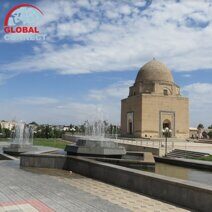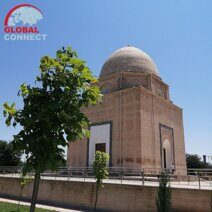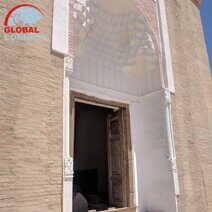Phones:
Mobile: +998941800001 (whatsapp, telegram)
Email:
karimov.sai@gmail.com
info@globalconnect.uz
Address:
str.Nodirabegim 6/22, 140103, Samarkand, Uzbekistan
We are next to Kapitalbank. Parking space is available in front of the building.
Office Hours:
9:00 am - 8:00 pm from Monday to Saturday
Rukhabad Mausoleum in Samarkand
Rukhabad Mausoleum, Samarkand
The mausoleum of Rukhabad is a 14th-century memorial and religious building in Samarkand, the burial place of an Islamic preacher, theologian and scholar-mystic Sheikh Burkhaneddin Klych Sagardzhi.
The mausoleum of Rukhabad was built by order of Amir Timur in 1380 over the grave of the Islamic religious leader Sheikh Burkhaneddin Sagardzhi, originally from the town of Sagarj, which became famous for the spread of Islam among the nomads of East Turkestan.
The time of the burial itself is not known exactly. The Islamic theologian Abu Hafsa Najmetdin Umar in "Kandia" refers the burial of Sheikh Burkhaneddin Sagardzhi to the X century. According to other sources, the sheikh’s grave appeared in Samarkand in 1287. However, most historians date the burial to the second half of the XIV century, based on the testimony of an Arab historian and traveler, Ibn Batutta, who visited India and China in the 40s of the XIV century and called Sagarji the head of the Muslim mission in Beijing.
Burkhaneddin Sagardzhi enjoyed great influence at the court of the Mongol Yuan dynasty that ruled in China and was even married to a "Chinese princess". He died in China, bequeathing to his son Abu Saeed to bury him in Samarkand.
 |
 |
 |
Soon after the construction of the mausoleum, Rukhabad becomes one of the most revered religious buildings of Samarkand. Timur himself, driving past the mausoleum, always dismounted from his horse. Later, south of Rukhabad, on behalf of his grandson Muhammad-Sultan, he built a spiritual center, which included a madrassah and a Sufi khanaka, which was connected with the burial vault of Burkhaneddin Sagardzhi by the Tsar’s Alley.
According to legend, Sheikh Burkhaneddin owned a copper box in which seven hairs from the beard of the Prophet Muhammad were stored and which during construction was walled up in the dome of the mausoleum. In addition to Burkhaneddin Sagardzhi, his wife, sons and relatives were later buried in the mausoleum of Rukhabad.
In subsequent years, the area around the mausoleum was repeatedly built up. In 1880-1882, a quarterly mosque decorated in Chinese style appeared near the mausoleum. In the middle of the XIX century, on the site of dilapidated buildings, a one-story madrasah was built, a minaret, and a pool (khauz) was dug. The mosque and the minaret have survived to this day. From the madrasah, a portal entrance with a lancet arch, flanked by guldast turrets, and gate structures were preserved.
Work to strengthen the mausoleum was carried out in the 1950s and in January 2016.
The mausoleum of Rukhabad is atypical for the time of the reign of Timur. The building does not have an entrance portal characteristic of this period, which makes all its facades equivalent. The mausoleum is a single-domed construction of a centric composition with an area of 14x12 meters and a height of 24 meters. Its base is a cube on which there is a transitional arched octahedron with light windows on the main axes. The structure is crowned by a spherical conic dome.
Three entrances lead to the mausoleum - from the north, west and south. The decoration of the mausoleum is very ascetic. Its exterior decor is dominated by burnt brick. Carved terracotta tiles are only framed by arched entrances. In the interior, at the base of the walls there is a two-meter ceramic panel, over which there are inserts of glazed tiles in the form of a narrow intermittent tape. The rest of the walls, arched sails and the dome are covered with alabaster.
Entrance fee: Free of charge
Top Sights of Samarkand
- Registan Square
- Sher-Dor Madrasah
- Tilla-Kori Madrasah
- Ulugbek Madrasah
- Bibi-Khanym Mosque
- Siab Bazaar
- Shakhi Zinda Necropolis
- Observatory of Ulugbek
- Mausoleum of St. Daniel
- Hazrat Khyzr Mosque
- Memorial Complex of Islam Karimov
- Memorial Complex of Imam al-Bukhari
- Meros Paper Mill
- Afrasiab Museum
- Ensemble of Khodja Akhrar
- Mausoleum Ishratkhana
- Mausoleum of Imam al-Moturidi
- Mausoleum of Khoja Abdi Darunee
- Settlement of Afrasiab
- Museum of Winemaking
- Chor Chinor Garden
- Hazrat Daud Cave
Related links
